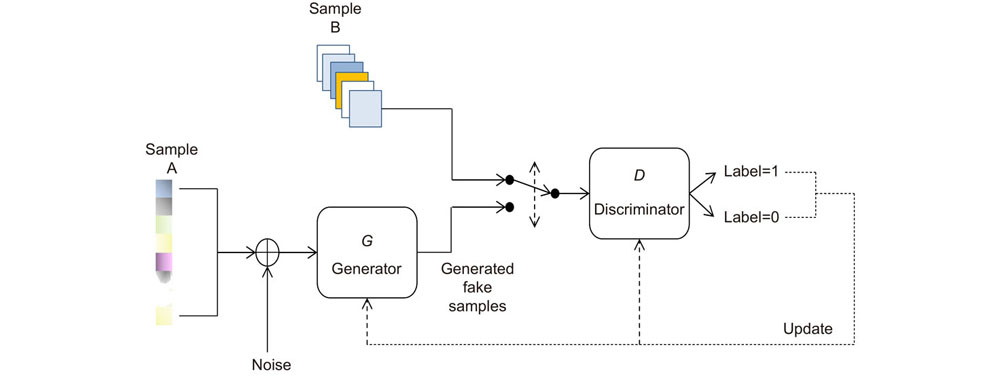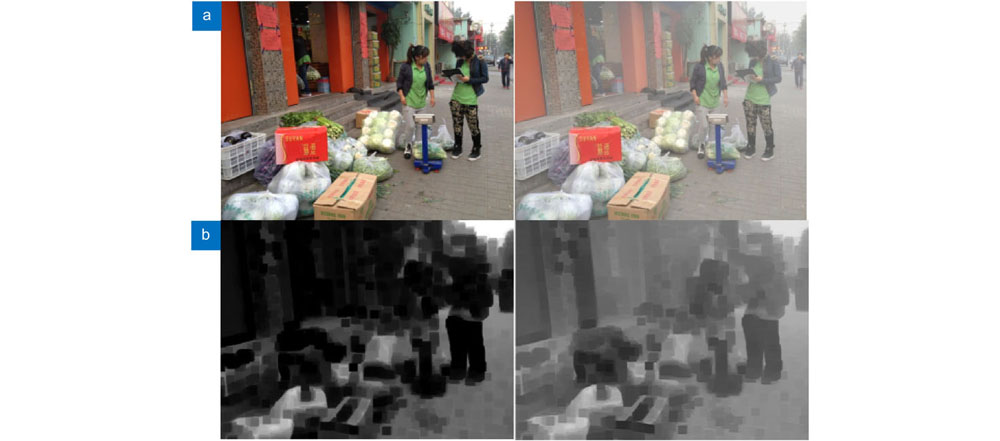Author Affiliations
1Engineering Research Center of Underground Space Intelligent Control, Ministry of Education, Xuzhou, Jiangsu 221000, China2School of Information and Control Engineering, China University of Mining and Technology, Xuzhou, Jiangsu 221000, China3School of Computer Science and Technology, China University of Mining and Technology, Xuzhou, Jiangsu 221000, Chinashow less
Fig. 1. Framework of adversarial generation network
Fig. 2. Dark channel feature comparison.(a) Original images; (b) Dark channel feature
Fig. 3. Dark channel feature intensity distribution. (a) Intensity distribution; (b) Average intensity distribution of 5000 images
Fig. 4. Framework of the proposed algorithm
Fig. 5. Qualitative comparison on synthetic images
Fig. 6. Qualitative comparison on real hazy images
Fig. 7. Quantitative comparison with control group on SOTS test-set & synthetic images of HSTS test-set
Fig. 8. Qualitative comparison with control groups on real images of HSTS test-set
Fig. 9. Quantitative comparison with control group on real hazy images of HSTS test-set
| 卷积层 | Conv | Res | | Conv | Res | | Conv | Res | | Upconv | Res | | Upconv | Res | | Conv | Tanh | | 输入通道数 | 3 | 64 | | 64 | 128 | | 128 | 256 | | 256 | 128 | | 128 | 64 | | 64 | 3 | | 输出通道数 | 64 | 64 | 128 | 128 | 256 | 256 | 128 | 128 | 64 | 64 | 3 | 3 | | 卷积核尺寸 | 7 | | 5 | | 3 | | 4 | | 4 | | 7 | | | 步长 | 1 | | 2 | | 2 | | 2 | | 2 | | 1 | | | 边界填充 | 3 | | 1 | | 1 | | 1 | | 1 | | 3 | |
|
Table 1. Parameters of generator network
| 卷积层 | Conv1 | Conv2 | Conv3 | Conv4 | Conv5 | | 输出通道数 | 64 | 128 | 256 | 512 | 1 | | 卷积核大小 | 4 | 4 | 4 | 4 | 4 | | 步长 | 2 | 2 | 2 | 1 | 1 |
|
Table 2. Parameters of the discriminator network
| 数据集 | HSTS | | SOTS-outdoor | | SOTS-indoor | | 评价指标 | PSNR | SSIM | PSNR | SSIM | PSNR | SSIM | | DCP[7] | 17.22 | 0.80 | | 17.56 | 0.82 | | 20.15 | 0.87 | | BCCR[9] | 15.09 | 0.74 | 15.49 | 0.78 | 16.88 | 0.79 | | CAP[10] | 21.54 | 0.87 | 22.30 | 0.91 | 19.05 | 0.84 | | MSCNN[15] | 18.29 | 0.84 | 19.56 | 0.86 | 17.11 | 0.81 | | D-Net[16] | 24.49 | 0.92 | 22.72 | 0.86 | 21.14 | 0.85 | | AOD-Net[17] | 21.58 | 0.92 | 21.34 | 0.92 | 19.38 | 0.85 | | GFN[18] | 22.94 | 0.87 | 21.49 | 0.84 | 22.32 | 0.88 | | DEnergy[26] | 24.44 | 0.93 | 24.08 | 0.93 | 19.25 | 0.83 | | 本文算法 | 25.35 | 0.96 | 25.17 | 0.96 | 23.70 | 0.82 |
|
Table 3. Quantitative results of each algorithm on SOTS test-set & synthetic images of HSTS test-set
| 数据集 | D-HAZY | | HazeRD | | BeDDE | | 评价指标 | PSNR | SSIM | PSNR | SSIM | VSI | VI | RI | | DCP[7] | 15.09 | 0.83 | | 14.01 | 0.39 | | 0.946 | 0.911 | 0.965 | | MSCNN[15] | 13.57 | 0.80 | 15.58 | 0.42 | 0.947 | 0.892 | 0.972 | | D-Net[16] | 13.76 | 0.81 | 15.53 | 0.41 | 0.952 | 0.890 | 0.972 | | AOD-Net[17] | 13.13 | 0.79 | 15.63 | 0.45 | 0.954 | 0.896 | 0.970 | | CycleGAN[22] | 13.55 | 0.77 | 15.64 | 0.44 | 0.942 | 0.866 | 0.961 | | RefineDNet[39] | 15.44 | 0.83 | 15.61 | 0.43 | 0.960 | 0.907 | 0.971 | | SM-Net[24] | 15.32 | 0.81 | 15.55 | 0.40 | 0.961 | 0.899 | 0.969 | | 本文算法 | 15.39 | 0.82 | 15.59 | 0.44 | 0.967 | 0.899 | 0.967 |
|
Table 4. Quantitative results of each algorithm on D-HAZY & HazeRD & BeDDE test-set
| | Pic1 | Pic2 | Pic3 | Pic4 | Pic5 | Pic6 | Pic7 | Pic8 | Pic9 | Pic10 | | 对照组1 | e | 0.0162 | -0.0506 | 0.0868 | 0.1629 | 0.3869 | 0.3391 | 0.6262 | 1.0014 | 0.9579 | 0.0160 | | r | 1.0100 | 1.0435 | 1.1291 | 1.0450 | 1.6743 | 1.4286 | 1.4641 | 1.4606 | 1.8278 | 1.0928 | | p | 0.0000 | 0.0000 | 0 | 0.0019 | 0 | 0.0002 | 0 | 0.0002 | 0.0003 | 0.0000 | | 对照组2 | e | 0.3360 | 0.6421 | 0.2709 | 0.0774 | 0.3833 | 0.4338 | 0.7845 | 1.8348 | 0.6207 | 0.4650 | | r | 1.4605 | 1.4222 | 1.2640 | 1.2047 | 1.6926 | 1.4382 | 1.3379 | 1.5126 | 1.6021 | 1.1351 | | p | 0.0102 | 0.1155 | 0.0001 | 0.0081 | 0 | 0.0072 | 0.0002 | 0.0081 | 0.0016 | 0.0286 | | 本文算法 | e | 0.3534 | 0.6061 | 0.8870 | 0.1232 | 0.4504 | 0.6265 | 1.2378 | 2.0714 | 1.1443 | 0.5197 | | r | 1.6284 | 1.5576 | 1.6631 | 1.3572 | 2.1599 | 1.6863 | 1.5793 | 1.7814 | 1.9561 | 1.3026 | | p | 0.0082 | 0.1015 | 0.0001 | 0.0020 | 0 | 0.0079 | 0.0011 | 0.0108 | 0.0013 | 0.0153 |
|
Table 5. Quantitative results of the control groups & proposed algorithm on real images of HSTS test-set
| DCP[7] | CAP[10] | MSCNN[15] | D-Net[16] | AOD-Net[17] | GFN[18] | CycleGAN[22] | 本文算法 | | Device | CPU | CPU | GPU | CPU | GPU | GPU | GPU | GPU | | Run time | 1.74 | 0.72 | 3.41 | 3.33 | 0.56 | 6.10 | 2.96 | 1.37 |
|
Table 6. Run time of each algorithm on SOTS test-set






